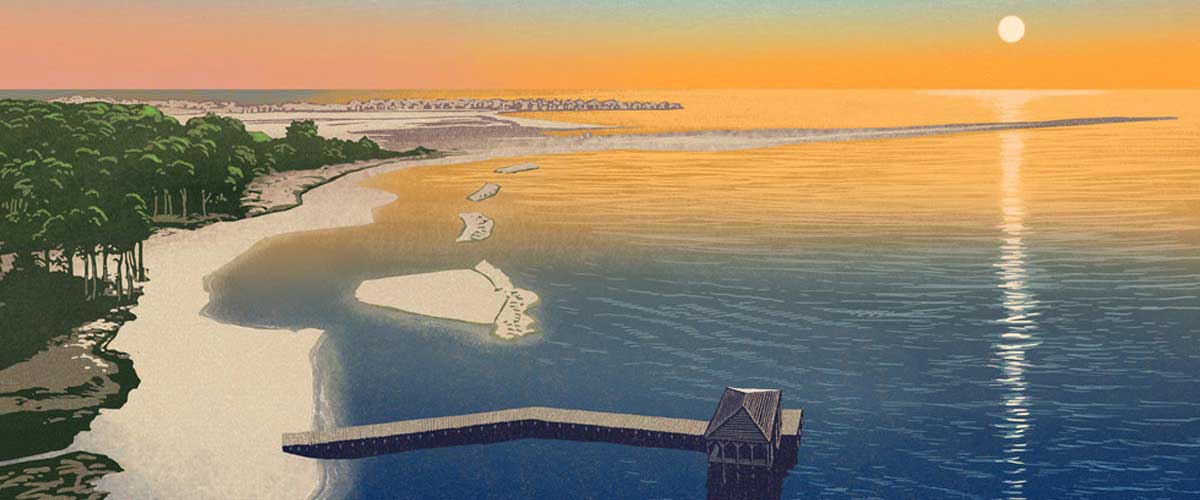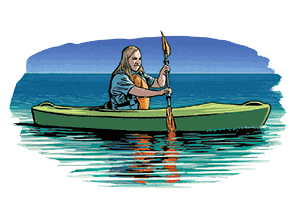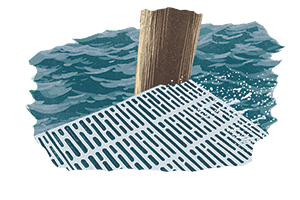Let's Have Class Outside
Posted on June 5, 2025 by Steve Millburg

If all goes according to plan, by fall 2025, students at the Stokes School of Marine and Environmental Sciences will study at an outdoor classroom built over a beautiful bay.
“And then the idea is,” says the school’s director, Dr. Sean Powers, “as soon as the
lecture’s over, they step right into
the water and do whatever their class assignment is.”
How cool will that be? And what an enticing recruiting tool this Outdoor Living Lab will make for what is already the University of South Alabama’s fastest-growing school or college. “We had 49 graduate students four years ago,” Powers says. “We now have 100 graduate students and 200 undergraduates.”
Five South civil engineering students designed the Outdoor Living Lab as a senior capstone project.
The idea grew from a 2023 donation to South from the University of South Alabama Foundation: 60 acres of Dauphin Island bayfront land, most of it submerged, valued at nearly $2 million. The serene property, with a white sand beach and gorgeous sunset views, is on (and under) Aloe Bay, just west of the Dauphin Island Causeway and 40 minutes south of South’s campus.
The foundation regularly asks the University about its needs, says foundation Managing Director Maxey Roberts. The Aloe Bay property had been discussed for a while, so the foundation turned down interested buyers until the time was right for the donation.
“The University is putting it to excellent use,” Roberts says. “They have wonderful
plans that are going to support a phenomenal program.”
The property was part of a shoreline restoration project this spring that two South
faculty members helped guide: Dr. Bret Webb, professor of civil and coastal engineering,
and Dr. Ronald Baker, assistant professor of marine sciences and a senior marine scientist
at the Dauphin Island Sea Lab.
Meg Goecker ’01 of Moffatt & Nichol, a coastal and ports consulting company, is project manager. While an undergraduate at Michigan State, Goecker spent a semester at the Dauphin Island Sea Lab.
“I fell in love with the Gulf Coast that semester,” she says. She came to South to earn a master’s degree in marine sciences and now lives on Dauphin Island.
The restoration project extended the shoreline to its 1950s boundaries, restoring marshes and tidal creeks. It also added an oyster reef consisting of oyster shells donated by Wayne Eldridge of J&W Marine Enterprises in Bayou La Batre, Alabama.
A long pier will extend to the open-sided Outdoor Living Lab, equipped with ceiling fans to augment the cooling power of the sea breezes. The Stokes School will moor a 35-foot boat alongside. Boardwalks leading to the pier will protect marshes.
Most of that part of the bay is less than three feet deep. “You’d be amazed that, even though we have marine sciences students from all over the country, a lot of them still don’t know how to swim well,” Powers says.
“Having some shallow, very safe water that’s very protected from most storms, with no rip currents, really gives us an excellent resource.”
A $250,000 grant from the Alabama Department of Conservation and Natural Resources, headed by South alum Chris Blankenship ’92, made the outdoor classroom possible.
“We in the Department of Conservation hire many marine biologists, environmental scientists
and natural resource planners,” says Blankenship, who grew up on Dauphin Island. “So
we think it’s wise to invest in
the university that educates those students that hopefully will become future employees
for our department or other agencies and companies that we work in tandem with.”
He says shoreline restoration, which the department also helped fund, aids Alabama’s seafood industry by rejuvenating the marshes that act as nurseries for juvenile fish and crustaceans.
All in all, Blankenship says, “There’s no better place to educate students in the marine sciences than right here on the Alabama Gulf Coast.”
 WALKING IN WATER
WALKING IN WATER
Students will be able to step outside the outdoor classroom at Aloe Bay and cast nets in waist-deep water.
 RECREATION
RECREATION
The classroom at Aloe Bay comes with kayaks, and students will be encouraged to get out there and go exploring.
 STORM RESISTANT
STORM RESISTANT
All boardwalks and decking will be made from flow-through reinforced polypropylene, making the structure resistant to damage from rough waters.
Click here to view the current issue of South Magazine


